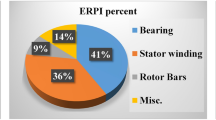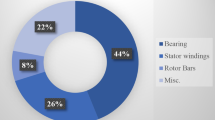Abstract
This paper presents the resonance issue of an aged induction motor to restrict the vibrations of the machine to a permissible limit. To mitigate the resonance problem, forced vibration analysis (FVA), natural frequency test (NFT), and experimental modal analysis (EMA) are implemented on an induction motor. FVA and NFT are performed to predict the prime cause of resonance and identify the mechanical fault in the motor casing which is not within the permissible limit. The resonance in the machine leads to an electrical fault. EMA is executed on the stator windings by considering 12 test points that help to determine the looseness of the windings. Using the numerical method and experimental methods, the problem of resonance is identified and resolved. As per ISO standards 10,816, the vibration velocity of the induction motor must be within 5 mm/s. In the induction motor under test, it is observed that the vibration velocity is 15.3 mm/s using numerical analysis which violates the ISO standards. Remodeling and redesign of induction motor are done numerically using ANSYS. These results yield the vibration velocity to be 4.4 mm/s which resolves the resonance.
















Similar content being viewed by others
Abbreviations
- FVA:
-
Forced vibration analysis
- NFT:
-
Natural frequency test
- EMA:
-
Experimental modal analysis
- FEM:
-
Finite element method
- ISO:
-
International organization for standardization
- ODS:
-
Operational deflection shape
- FRF:
-
Frequency response function data set
- EDM:
-
Engineering data management
- MDE:
-
Motor drive end
- FFT:
-
Fast Fourier transform
- MAC:
-
Modal assurance criteria
References
Bai Y, Yu K, Zhao R, Zhou H (2018) Impact series shaker excitation approach for structural modal testing in thermal environments. Exp Tech 42(4):429–438. https://doi.org/10.1007/s40799-018-0253-2
Chai F, Li Y, Pei Y, Li Z (2018) Accurate modelling and modal analysis of stator system in permanent magnet synchronous motor with concentrated winding for vibration prediction. IET Electr Power Appl 12(8):1225–1232. https://doi.org/10.1049/iet-epa.2017.0813
Yin H, Zhang X, Ma F, Gu C, Gao H, Wang Y (2020) New equivalent model and modal analysis of stator core-winding system of permanent magnet motor with concentrated winding. IEEE Access 8:78140–78150. https://doi.org/10.1109/ACCESS.2020.2989141
Lee JH, Kim YJ, Mun BC (2019) The earthquake safety assessment of 1000 kVA cast resin transformer by finite element analysis with mesh convergence and seismic test on the large shaking table under Korean and IEEE seismic standards. J Electr Eng Technol 14(3):1223–1233. https://doi.org/10.1007/s42835-019-00125-w
Logan P, Fowler D, Avitabile P, Dodson J (2020) Reconstruction of nonlinear contact forces beyond limited measurement locations using an SVD modal filtering approach. Exp Tech 44(4):485–495. https://doi.org/10.1007/s40799-020-00371-y
Sun W, Li R, Jiang JX (2019) Lumped-parametric modeling based on modal test and analysis of vibration characteristics of the hard-coated blisk. J Vib Eng Technol 7(4):347–358. https://doi.org/10.1007/s42417-019-00127-y
Kordkheili SH, Massouleh SM, Hajirezayi S, Bahai H (2018) Experimental identification of closely spaced modes using NExT-ERA. J Sound Vib 412:116–129. https://doi.org/10.1016/j.jsv.2017.09.038
Zhao Y, Yan B, Chen C, Deng J, Zhou Q (2014) Parametric study on dynamic characteristics of turbogenerator stator end winding. IEEE Trans Energy Convers 29(1):129–137. https://doi.org/10.1109/TEC.2013.2294334
Iga Y, Takahashi K, Yamamoto Y (2016) Finite element modelling of turbine generator stator end windings for vibration analysis. IET Electr Power Appl 10(2):75–81. https://doi.org/10.1049/iet-epa.2015.0142
Zhao Y, Yan B, Zeng C, Huang S, Chen C, Deng J (2016) Optimal scheme for structural design of large turbogenerator stator end winding. IEEE Trans Energy Convers 31(4):1423–1432. https://doi.org/10.1109/TEC.2016.2597151
Hassan OE, Amer M, Abdelsalam AK, Williams BW (2018) Induction motor broken rotor bar fault detection techniques based on fault signature analysis—a review. IET Electr Power Appl 12(7):895–907. https://doi.org/10.1049/iet-epa.2018.0054
Prasad KVSR, Singh V (2020) Looseness identification of stator end windings of induction motor by modal test. In 2020 IEEE International Conference on Power Electronics, Drives and Energy Systems (PEDES) (pp. 1–5). IEEE. DOI: https://doi.org/10.1109/PEDES49360.2020.9379438.
Tompkins M, Stakenborghs R, Kramer G (2016) Use of FEA software in evaluating pump vibration and potential remedial actions to abate resonance in industrial vertical pump/motor combinations. In International Conference on Nuclear Engineering (Vol. 50015, p. V001T01A011). American Society of Mechanical Engineers. DOI: https://doi.org/10.1115/ICONE24-60890
Ganesh P, Krishna SR (2020) Diagnosis and resolution of vibration issues in vertical centrifugal pump. J Fail Anal Prev 20(3):1019–1028. https://doi.org/10.1007/s11668-020-00910-0
Spyropoulos DV, Mitronikas ED (2013) A Review on the faults of electric machines used in electric ships. Adv Power Electron. https://doi.org/10.1155/2013/216870
Yetgin AG (2019) Effects of induction motor end ring faults on motor performance. Experimental results. Eng Fail Anal 96:374–383. https://doi.org/10.1016/j.engfailanal.2018.10.019
El-Gazzar DM (2017) Finite element analysis for structural modification and control resonance of a vertical pump. Alex Eng J 56(4):695–707. https://doi.org/10.1016/j.aej.2017.02.018
Li S, Zhang L, Liang Z, Kong C (2021) Experimental and numerical analysis for vibration identification and mitigation of a coalescer system. Eng Fail Anal 120:105040. https://doi.org/10.1016/j.engfailanal.2020.105040
Lin R, Laiho AN, Haavisto A, Arkkio A (2010) End-winding vibrations caused by steady-state magnetic forces in an induction machine. IEEE Trans Magn 46(7):2665–2674. https://doi.org/10.1109/TMAG.2010.2044043
Sewak R, Ranjan R, Kumar V (2011) Experimental modal analysis of stator overhangs of a large turbogenerator. Energy Power Eng 3(3):221–226. https://doi.org/10.4236/epe.2011.33028
Wróblewski S, Napieralski A (2012) A multichannel measurement system for online turbogenerator vibration diagnostics. IEEE Trans Energy Convers 27(4):978–983. https://doi.org/10.1109/TEC.2012.2208645
Schlegl B, Schönleitner F, Marn A, Neumayer F, Heitmeir F (2012) Analytical determination of the orthotropic material behavior of stator bars in the range of the end windings. In 6th IET International Conference on Power Electronics, Machines and Drives (PEMD 2012) (pp. 1–8). IET. DOI: https://doi.org/10.1049/cp.2012.0283.
Verma AK, Radhika S (2021) Multi-level stator winding failure analysis on the insulation material for industrial induction motor. Exp Tech. https://doi.org/10.1007/s40799-021-00490-0
Acknowledgements
The authors would like to thank “Flamboyant Solutions” for their valuable advice and significant support in performing the experimental work.
Author information
Authors and Affiliations
Corresponding author
Additional information
Publisher's Note
Springer Nature remains neutral with regard to jurisdictional claims in published maps and institutional affiliations.
Rights and permissions
About this article
Cite this article
Prasad, K.V.S.R., Singh, V. Numerical Investigation and Experimental Modal Analysis Validation to Mitigate Vibration of Induction Machine Caused due to Electrical and Mechanical Faults. J. Electr. Eng. Technol. 17, 2259–2273 (2022). https://doi.org/10.1007/s42835-022-01049-8
Received:
Revised:
Accepted:
Published:
Issue Date:
DOI: https://doi.org/10.1007/s42835-022-01049-8




